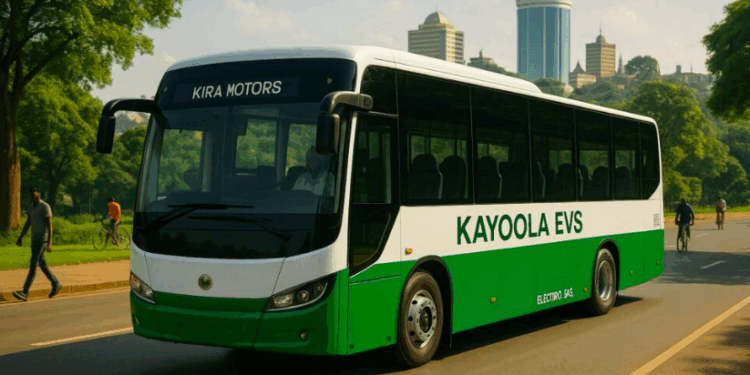Uganda is shifting gears into a cleaner future—and it’s doing so in style. With the introduction of Kayoola EVS electric buses, Kampala is now seeing the first wave of modern, eco-conscious public transportation. Designed and manufactured by Kiira Motors Corporation (KMC), these buses are more than just a ride; they’re a statement. A statement of sustainability, innovation, and national pride.
The Launch of Kayoola EVS Buses
The Kayoola EVS lineup officially rolled into Kampala to wide public and government acclaim. These buses have been tailor-made for the chaotic pulse of Kampala’s streets—complete with tech that’s smarter, cleaner, and more efficient than anything currently on the roads.
Backed by Uganda’s government and embraced by institutions like the Uganda Civil Aviation Authority (UCAA), the rollout is more than a mobility upgrade. It’s the start of a homegrown movement.
Environmental Impact
Reducing CO₂ Emissions
Let’s talk numbers: 181 metric tonnes of CO₂ saved per bus annually. That’s huge—especially in Kampala, where vehicle emissions make up a significant chunk of pollution. Diesel buses don’t just guzzle fuel; they choke the air. Kayoola EVS buses operate quietly and cleanly, with zero tailpipe emissions.
Combatting Kampala’s Pollution Crisis
Air quality in Kampala has exceeded WHO’s safe limits by a factor of eight. The culprit? High-carbon diesel transport. The solution? Buses like the Kayoola EVS. By 2030, adopting electric buses could save over 3,700 lives in Uganda’s capital alone.
Cost Efficiency of Kayoola Buses
Affordable Operational Costs
Running at just UGX 320 per kilometer, Kayoola buses crush the competition. Diesel buses average UGX 1,670/km—that’s over 5 times more expensive. Imagine the savings for fleet operators and government transport budgets!
Reduced Maintenance Costs
With fewer moving parts and no combustion engine, EVs like the Kayoola are naturally easier (and cheaper) to maintain. We’re talking 46% lower maintenance bills annually—money that can be reinvested into better service or lower fares.
Local Manufacturing Advantage
Supporting the Ugandan Economy
One of the standout features? These aren’t imports. Kayoola EVS buses are built in Uganda, with 21% of the materials locally sourced—including bamboo flooring. This isn’t just smart; it’s patriotic.
The Kiira Vehicle Plant
Located in Jinja, this plant is set to produce 22 vehicles per day, aiming for 5,000+ units annually in its first phase. Add in a growing Automotive Industrial and Technology Park, and you’ve got the makings of an industrial revolution.
Features Designed for Commuters
Passenger Comfort & Convenience
Whether you’re on your way to work or school, the Kayoola EVS makes your ride smooth. With Wi-Fi, USB charging ports, infotainment systems, and cashless payment, it’s designed for the modern passenger.
Enhanced Safety Systems
CCTV cameras monitor the interiors, while e-ticketing systems speed up boarding. The low-floor design is perfect for seniors, children, and passengers with disabilities.
Kayoola EVS Bus Models & Specifications
| Model | Range | Capacity |
|---|---|---|
| Kayoola EVS 8m | 124 miles | 56 (28 seated) |
| Kayoola EVS 10m | 155 miles | 70 |
| Kayoola EVS 12m | 186 miles | 90 |
| Tour Bus 6m | 62 miles | 20 |
The 560 kWh battery ensures long-range service, perfect for Kampala’s intense routes.
Boosting Uganda’s Urban Transit
Mass Transport Efficiency
Kayoola buses ease pressure on the road. Like Dar es Salaam’s BRT, which slashed commute times from 3 hours to 45 minutes, Kampala could follow suit—reducing congestion, time wasted, and stress.
Infrastructure Compatibility
The digital backbone (e-ticketing, real-time tracking) makes integration smooth. No overhaul needed—just plug, ride, and go.
Driving Uganda’s Economic Transformation
Reducing Vehicle Import Costs
Uganda spends $730 million annually importing vehicles. By building electric buses locally, much of that capital stays home—fueling jobs, taxes, and innovation.
Export Potential
With 3,700 buses set for West Africa, Uganda is no longer just a buyer—it’s a producer. It’s a regional leader in the EV space.
Electric Buses vs Diesel Buses
| Metric | Kayoola EVS | Diesel |
| Cost/km | UGX 320 | UGX 1,670 |
| CO₂ Emissions | Zero | 181 metric tonnes/year |
| Maintenance Cost | 46% lower | High |
| Noise | Silent | Loud |
| Energy Source | Renewable | Imported fuel |
Uganda’s Renewable Energy Advantage
Uganda generates 90% of its power from renewables, mainly hydro. This gives electric buses a cleaner supply chain—something diesel can’t match.
Kayoola EVS and Uganda’s Net-Zero Vision
By 2050, Uganda aims to hit Net-Zero Carbon Emissions. Kayoola EVS is part of that roadmap, aligned with national policies like the Buy Uganda, Build Uganda (BUBU) campaign.
Role of AUTO24.ug and EV Marketplaces
Where to Find Used EVs in Uganda
Want to join the electric revolution? Visit auto24.ug to explore a range of used electric vehicles already tailored for Uganda’s roads. You’ll find models from Nissan Leaf to Hyundai Kona—reliable, efficient, and future-ready.
Encouraging Individual EV Ownership
Public fleets are a great start, but private adoption is key. With platforms like auto24.ug, it’s now easier than ever to find budget-friendly EVs.
Conclusion
Uganda’s Kayoola EVS electric buses are more than just a transportation upgrade—they’re a national transformation. By addressing air pollution, lowering transport costs, and building local manufacturing strength, Uganda is paving a path many African countries could follow.
The ripple effect? Jobs, cleaner cities, and a globally competitive economy. From Kampala to West Africa, these buses represent a new chapter in African mobility—one that’s clean, smart, and proudly homegrown.
FAQs
1. How much CO₂ do Kayoola EVS electric buses save each year?
Each bus saves around 181 metric tonnes of CO₂ annually, significantly reducing greenhouse gas emissions in Kampala.
2. Are Kayoola EVS buses reliable for long-distance commutes?
Yes, with a range of up to 186 miles, these buses are perfect for daily urban routes and short intercity travel.
3. How does local manufacturing support Uganda’s economy?
It creates over 14,000 jobs, reduces import dependency, and strengthens national industries.
4. Where can I buy used EVs in Uganda?
Check out auto24.ug for a variety of pre-owned electric vehicles suitable for Uganda’s roads and climate.
5. What are the comfort features offered on Kayoola EVS buses?
Wi-Fi, USB ports, infotainment, e-ticketing, CCTV, and a low-floor design make the ride safe, inclusive, and enjoyable.




